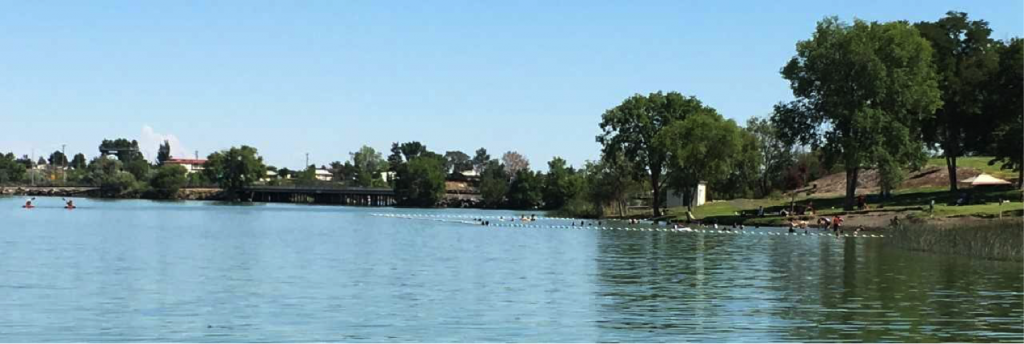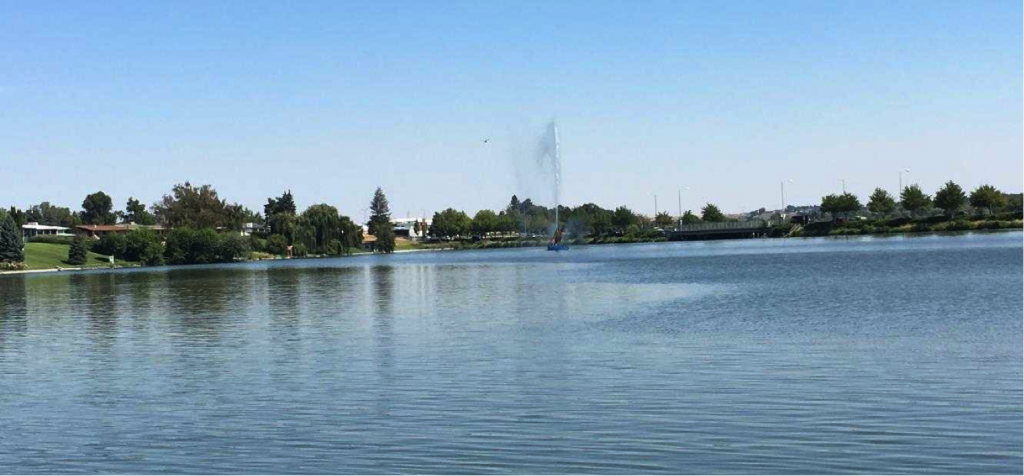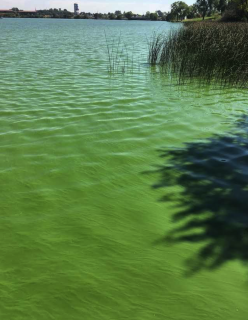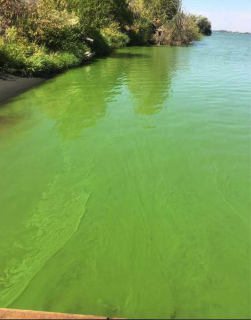by Gene Welch, Prof. Emeritus, Civil and Environmental Engineering, University of Washington
The recent detection of algal toxins in Moses Lake has stirred interest in the condition of the lake’s water quality. Microcystin, a toxin produced by a blue-green alga (cyanobacterium), was found at high concentrations in near-shore accumulations of algal mass. Algae grow in the open water, but only blue-greens are buoyant and often rise to the surface, resulting in scums that can be blown by wind and accumulate near shore. Thus, concentrations of microcystin are usually highest in such accumulations.

Despite the presence of blue-green algal toxins, the lake’s water quality has improved greatly over the past 40 years due to dilution by large inflows of low-phosphorus Columbia River Water (CRW) from the East Low Canal into Parker Horn through the south end and the lake outlet to irrigators to the south. This ongoing program was begun in 1977 through efforts of the Moses Lake Irrigation and Rehabilitation District (MLIRD) with cooperation of the U.S. Bureau of Reclamation (USBR) and funding from state and federal agencies. The other major factor was diversion of the City’s wastewater from Pelican Horn in 1984.

As a result, mainly from increased CRW inflows, water quality in Parker Horn and the south end improved in proportion to the volume of CRW due to its low phosphorus content. Phosphorus is the key nutrient that controls the concentration of algae and is related to the fraction represented by blue-greens, some of which can produce toxins. As the average volume of CRW input increased 25-fold during 1977-1988 from the early 1970s, phosphorus content in Parker Horn and the south end decreased by 50 percent. Phosphorus declined by another two thirds in that area during 2002-2016 as CRW increased another 2.5-fold, and the concentration of chlorophyll, an indicator of total algal abundance, also declined in proportion to phosphorus. Overall, phosphorus content decreased more than 80 percent. For more detail see: http://mlird.org/lake/GeneWelch_mosesoped2.pdf
Parker Horn, the south end and the Cascade area represent about half the lake’s volume and are the areas most affected by CRW input. The volume of CRW added during spring-summer over the past 40 years averaged three times that half-lake volume, which represented a substantial dilution of the lake’s normally high phosphorus content. That accounted for the marked improvement in water quality in Parker Horn and the south end. However, very poor water quality continued in upper Rocky Ford arm, because phosphorus content in the input from Rocky Ford Creek is very high and CRW input did not extend much more than halfway up that arm of the lake. Therefore, reduction in phosphorus is needed in upper Rocky Ford arm to reduce algal abundance, especially the concentration of toxin-producing blue-greens.
Water quality has been poorer and algal-bloom magnitude greater some years than others, even with similar inputs of CRW. Phosphorus and total algal concentration (chlorophyll) were much higher in Parker Horn and the south end this past summer than in 2017, even though CRW input was slightly more. That was probably due to more phosphorus entering the lake from other sources, especially from the lake’s bottom sediments. That internal source varied year-to-year by 100 percent and represented 45 percent on average of the total phosphorus input, including surface and ground water, during 1977-1988.
The frequency of harmful algal blooms, or HABs as they are commonly called, has increased world-wide. The role of climate change in that increase is uncertain, but timing of the spring increase of blue-greens blooms and species dominance are affected by temperature. Surface water temperature in Parker Horn and the south end during July and August was five degrees F higher in 2017-2018 than in 1986 -1988. Nevertheless, phosphorus is still the key; algae cannot grow and create blooms without adequate phosphorus. Although water quality has greatly improved over the years, blue-green algal blooms will probably continue with some years being more troublesome than others, but further lowering of lake phosphorus should result in less total algae on average as well as a smaller proportion of blue-greens. There are hundreds of lakes in the world that have recovered from poor water quality and large concentrations of blue-green algae through reduction of phosphorus input; for example, Lake Washington and Lake Spokane.
What are the possible alternatives for further reducing phosphorus in Moses Lake? The high phosphorus in upper Rocky Ford arm could be reduced by delivering similar quantities of CRW to that area, or alternatively, lowering the phosphorus content of the Rocky Ford Creek input. Importantly, MLIRD has resumed monitoring the lake’s water quality the past two years at multiple sites, consistent with those used by University of Washington personnel from the late 1960s and 1977-1988 and Washington Department of Ecology in 2001. Also, stream inflows and the lake outflow have been monitored by USBR since 1995. Sound data are necessary to manage the lake’s water quality properly.











